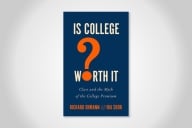You have /5 articles left.
Sign up for a free account or log in.
In U.S. Supreme Court Justice Anthony M. Kennedy’s 4 to 3 majority opinion in Fisher v. University of Texas, in which he upheld racial preferences in college admissions, he recalls that the court has said that enrolling a diverse student body “promotes cross-racial understanding, helps to break down racial stereotypes and enables students to better understand persons of different races.” Equally important, according to the court’s previous decisions, “student body diversity promotes learning outcomes and better prepares students for an increasingly diverse workforce and society.”
Unfortunately, Justice Kennedy’s decision significantly undermines the very goals the court hopes to achieve. Also unfortunate is that his memory is conveniently selective: he seems to have forgotten much of what he himself wrote in 2013’s Fisher I decision.
That’s a shame, because the country seemed ready to finally put an end to government discrimination on the basis of race and to have it start judging all people on the content of their character rather than the color of their skin, as Martin Luther King Jr. admonished. The court has long suggested racial preferences in admissions were temporary, and in Fisher I, Justice Kennedy set the stage to finally end them. In that opinion, he wrote: “Judicial review must begin from the position that ‘any official action that treats a person differently on account of his race or ethnic origin is inherently suspect.’”
Justice Kennedy also wrote, “Courts must apply strict scrutiny to racial preferences, which must be narrowly tailored and used only if the same goals can't be met with race-neutral means.” In Fisher I, Justice Kennedy explicitly rejected the court of appeals approach of giving deference to the University of Texas and remanded the case, instructing the court of appeals to properly apply strict scrutiny -- which, according to Justice Kennedy at that time, meant that it was to be applied without deference to UT’s claims and unsupported conclusions. That is, UT had the burden to prove that race-conscious admissions were the least restrictive means possible for achieving its diversity goals. Moreover, Justice Kennedy had previously written, in a different case: “Classifying and assigning students” according to race “requires more than … an amorphous end to justify it.”
As Justice Samuel A. Alito noted in his dissent in Fisher II, something strange has happened since Fisher I. Something strange indeed. Under Justice Kennedy’s mercurial race jurisprudence, he has decided in Fisher II that UT is entitled to considerable deference with respect to intangibles like diversity. UT did not prove that race-conscious admissions are the only way that it could achieve diversity, and it also did not clearly articulate the goals that its admissions process is designed to achieve. Nevertheless, Justice Kennedy decided that UT’s use of racial preferences in admissions is constitutional.
I am afraid that this decision will continue the pernicious questioning that hangs over legally favored minority students (nonfavored minority students, such as Asian students, get no preference): Were they admitted to a prestigious university because of their ability or because of their skin color?
Also, similar questions will continue to be asked by every nonfavored minority student and majority student who is not accepted: Were they rejected because of their ability or because of their skin color? Today, given the politically correct atmosphere, especially on campuses, these questions are often unspoken. Nevertheless, people are not only asking them but, in many cases, answering them for themselves in the affirmative -- thereby perhaps diminishing someone’s achievements without reason. The fact that these judgments are unspoken makes them no less devastating to the very goals the court hopes diversity will achieve. As a result of Justice Kennedy’s opinion, these questions continue to be legitimate and relevant, even though they should not be.
In the Fisher cases, Abigail Fisher contends that UT rejected her because she is white. The university uses a holistic approach to admissions in which race is one of the considered factors.
In Fisher I, the court ruled 7 to 1 that race-conscious admissions are subject to strict scrutiny and sent the case back to the court of appeals for the proper application of that standard. As noted, the court demanded that UT prove that its race-conscious admissions process is the least restrictive means available to achieve diversity. But UT has had great success in increasing diversity with a race-neutral top 10 percent program, which automatically admits students in the top 10 percent of their high school class. Because of that, it seemed unlikely that a race-conscious plan would be held to be constitutional.
However, after rehearing the case, the court of appeals upheld UT’s race-conscious admissions standards, finding that UT had a legitimate interest in not only interracial diversity but also in intraracial diversity. Speaking plainly, the university claimed it needed to take race into account in order to admit minority students from affluent families because such students would be more likely to succeed in college and help to dispel stereotyping than those admitted under the percent program (who often come from racially segregated high schools).
In other words, UT assumed that students in the top 10 percent of predominantly black high schools would not have as strong a likelihood of succeeding in college as those from other high schools. This type of race-based discrimination and stereotyping is, of course, exactly what the Equal Protection Clause is meant to prevent.
Nevertheless, Justice Kennedy’s opinion does not address either the percent plan or the new intraracial justification for considering race in admissions that was argued in the court of appeals. Rather, he has now determined that the data on the percent plan was inadequate in 2008, when Abigail Fisher was rejected, to determine its success in achieving diversity.
That means that UT’s admissions policy that is applicable today may or may not be constitutional. The technical constitutional issue is whether the plan passes the strict scrutiny standard of constitutional review. Typically, this standard is strict in theory, but fatal in fact. Specifically, because UT did not produce the data necessary to establish that the percent plan was not adequate, and that a race-conscious plan was necessary to achieve diversity, the race-conscious plan should have failed the strict scrutiny standard. That is why most experts expected the court to find that the Texas plan was unconstitutional. However, Justice Kennedy concluded that the Texas plan, the holistic review where race is a “factor of a factor of a factor,” is in fact narrowly tailored enough, based solely on the newfound deference that he now says is due to UT, to pass strict scrutiny analysis.
The strict scrutiny test has two parts. The first requires that the interest to be served by the challenged practice (in this case, race-conscious admissions standards that give a boost to certain candidates because of their race) involve a compelling state interest. The second requirement is that the means to achieve that compelling state interest (in this case, race-conscious admissions standards) must be the least restrictive means possible.
There’s no question that a diverse student body is a compelling state interest. The issue in Fisher I and II was whether the race-conscious plan was necessary to achieve a diverse student body. If diversity could be achieved with a race-neutral plan (the top 10 percent plan or some other race-neutral approach) then any race-conscious plan would not be necessary to achieve the compelling state interest and therefore would have been unconstitutional. Yet the court simply offered no guidance on this issue.
Justice Kennedy states that UT must regularly evaluate its student body data and the experiences of its students and tailor its admissions approach in light of changing circumstances in order to ensure that race plays no greater role than is necessary to meet its compelling interest in a diverse student body. However, under the new deference standard, this requirement is essentially meaningless. UT basically told the court, as it did in Fisher I, that the court should essentially “trust us,” despite the fact “we cannot prove it or explain how, we nevertheless know when racial preferences are necessary and we will know when they are no longer necessary.” This time, the changeable Justice Kennedy has decided to trust them.
The inherent problem with affirmative action is that it claims that race is a legitimate basis upon which to judge someone, while the Constitution says that it is not. Ultimately, the court will recognize that race can never be used by public institutions in making admissions decisions. But Justice Kennedy’s newfound reluctance to recognize this fact in Fisher II has unnecessarily postponed that day.








